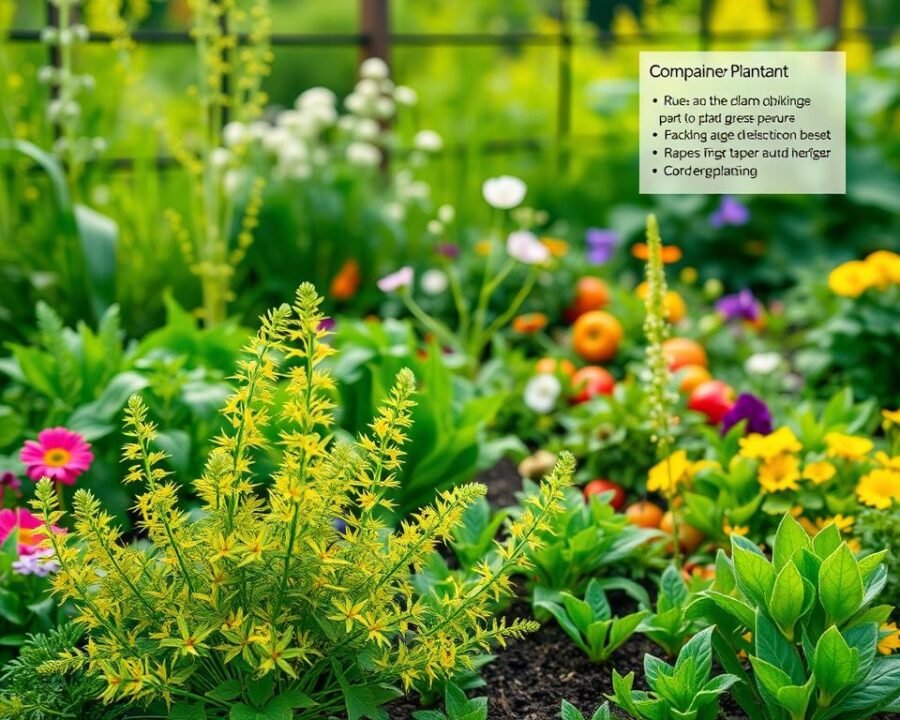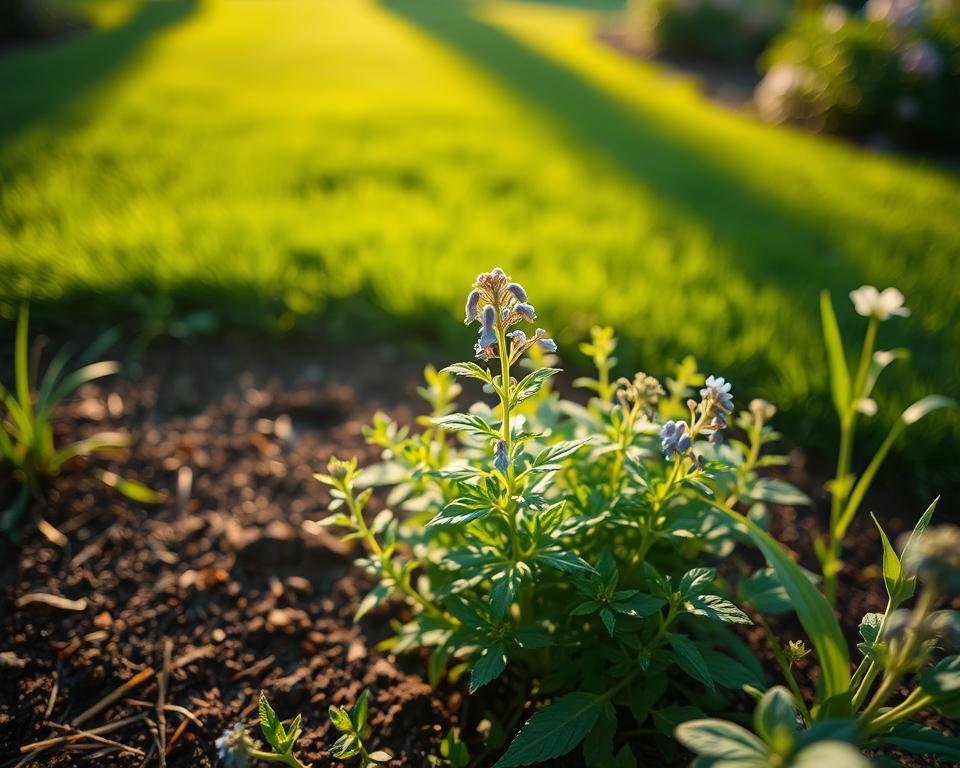Have you ever admired a garden bursting with charm and history? Rue, often called the Herb of Grace, carries centuries of tradition in its delicate blue-green leaves. This Mediterranean gem thrives effortlessly, bringing beauty and purpose to any space.
With its striking yellow summer blooms, this versatile addition attracts butterflies while resisting drought. Whether you’re a seasoned gardener or just starting, Rue fits seamlessly into zones 4-10, making it accessible across the U.S.
Beyond its ornamental appeal, this resilient plant requires minimal care. Discover its self-seeding magic and smart companion pairings to elevate your outdoor sanctuary.
Key Takeaways
- Rue, or Herb of Grace, blends beauty with historical significance
- Thrives in USDA zones 4-10 with drought-resistant qualities
- Produces vibrant yellow flowers that attract pollinators
- Low-maintenance but benefits from seed head management
- Ideal for ornamental gardens and practical landscapes
What Is Herb of Grace (Ruta Graveolens)?
From biblical times to modern gardens, this plant has worn many names. Known scientifically as Ruta graveolens, its legacy spans continents and cultures. Often called “herb of grace,” it earned this title through Catholic blessing rituals.
Historical Significance and Common Names
The Greeks dubbed it peganon, while Romans used it in cooking and medicine. By medieval times, people hung its leaves to ward off plague. Its botanical name hints at its bold nature—graveolens means “strong-smelling.”
Alternative names reflect its roles:
- Common rue: For everyday medicinal uses
- Garden rue: Celebrated in ornamental landscapes
- Herb-of-grace: Tied to religious ceremonies
Key Characteristics: Appearance and Fragrance
This perennial grows 2-3 feet tall with striking blue-green foliage. From June to October, yellow flowers form umbrella-like clusters. Swallowtail butterflies adore them.
The fragrance surprises—citrusy when brushed, musky when crushed. Below, a table contrasts historical and modern uses:
| Era | Primary Use | Notes |
|---|---|---|
| Ancient Rome | Culinary spice | Bitter flavor enhancer |
| Middle Ages | Plague protection | Hung in doorways |
| Modern Day | Ornamental/deer-resistant | Phototoxic—handle with care |
Ethiopian traditions still use its seeds in coffee ceremonies. Today, gardeners value it for pollinator appeal and drought tolerance.
How to Grow Herb of Grace Plant Everyone is Using
With its Mediterranean roots, Rue flourishes in conditions mirroring its native habitat. Understanding its preferences ensures lush growth and vibrant blooms.
Ideal Growing Conditions: Sun, Soil, and Climate
This hardy plant demands at least six hours of daily sun. Partial shade works, but full light intensifies its blue-green foliage. Well-draining, alkaline soil (pH 6.0-8.0) mimics its rocky origins.
Amend heavy clay with sand or gravel. For humid regions, raised beds prevent waterlogging. Container gardeners should opt for 10-liter pots with lime-enriched mix.
Starting from Seeds vs. Cuttings
Seeds need surface sowing in spring—light triggers germination. Keep temperatures between 50-64°F for four weeks. Pre-chilling boosts success in colder zones.
Cuttings root best in summer. Use a sand-perlite blend and avoid overwatering. Mature stems from healthy plants yield the strongest starts.
Space plants 12 inches apart for airflow. Whether ground or pot, Rue’s drought tolerance reduces fuss. Just avoid soggy roots!
Planting and Propagation Tips
Getting Rue established in your gardens starts with smart planting techniques. Whether you’re working with seed or transplants, timing and method matter. Here’s how to ensure your Rue thrives from day one.

Step-by-Step Seed Sowing Guide
For spring planting, surface-sow seeds with less than 1cm of soil covering. Light boosts germination, so avoid burying them deeply. Indoor starts work best 6–8 weeks before the last frost:
- Zone 4–6: Start indoors March–April
- Zone 7–10: Direct sow after frost risk passes
Struggling with slow sprouts? Pre-chill seeds for a week to mimic winter conditions. Keep temps steady at 50–64°F for consistent growth.
“Rue seeds demand patience—germination can take 14–30 days. Resist overwatering to prevent rot.”
Transplanting and Spacing Recommendations
Move seedlings outdoors once they hit 4 inches tall. Preserve the rootball to minimize shock. For ground planting, space mature specimens 12–18 inches apart. This prevents overcrowding and improves airflow.
Pro Tip: Harden off transplants gradually. Start with 2 hours of outdoor time daily, increasing over a week. Stake young plants in windy areas to avoid breakage.
- Container Mix: 2 parts compost, 1 part sand, 1 part lime
- Mulching: Use gravel or bark—keep it away from stems
- Self-Seeding Control: Deadhead flowers before seeds form
In warmer zones, succession planting ensures year-round beauty. Sow new batches every 8 weeks for continuous growth.
Caring for Your Rue Plant
This resilient perennial rewards gardeners who master its simple needs. While Rue survives neglect, strategic care enhances its blue-green foliage and golden blooms. We’ll explore watering, pruning, and feeding routines that keep this Mediterranean native thriving.

Watering and Drought Tolerance
Established rue needs just 0.5″ water weekly. Overwatering causes more harm than drought. Create a dry-spell response plan:
- Check soil 2″ deep—water only if completely dry
- Morning irrigation prevents fungal issues
- Use gravel mulch to retain moisture
Raised beds or containers prevent root rot in humid regions. Watch for curled leaves—the first sign of thirst.
Pruning for Bushier Growth
Spring is ideal for cutting stems to 6-8″. Angle cuts at 45° above leaf nodes encourage branching. Regular trimming prevents leggy growth.
“Prune after flowering to shape plants and control self-seeding. Always wear gloves—the sap irritates skin.”
Deadheading spent blooms redirects energy to foliage. For seed collection, leave some flower clusters intact.
Fertilizing: Less Is More
A balanced 10-10-10 formula at ¼ strength once per year suffices. Apply in early spring as new growth emerges. Organic options like compost tea work well.
Watch for these signs of nutrient issues:
- Pale leaves: Needs nitrogen
- Leaf scorch: Over-fertilization
- Stunted growth: Check soil pH
Foliar sprays offer quick fixes without risking root burn. Always water before feeding.
Companion Planting and Garden Uses
Strategic plant pairings can make or break your garden’s success. Rue’s allelopathic properties—natural chemicals that affect nearby growth—demand careful planning. When matched correctly, this herb becomes a powerhouse protector and pollinator magnet.

Best Plants to Pair with Rue
Onions form a dynamic duo with Rue, deterring flies while enhancing soil conditions. Roses benefit from Rue’s aphid-repelling oils, producing healthier flowers. For edible landscapes, raspberries thrive alongside this protective partner.
Consider these winning combinations:
- Pollinator gardens: Milkweed and zinnias attract butterflies
- Rock gardens: Sedum and lavender complement Rue’s drought tolerance
- Deer-resistant borders: Combine with Russian sage and yarrow
Plants to Avoid Near Rue
Basil and sage struggle near Rue’s phytotoxins. Nightshades like tomatoes and cucumbers often show stunted growth. Keep these sensitive plants at least 3 feet away.
This table highlights key interactions:
| Companion | Effect | Ideal Distance |
|---|---|---|
| Onions | Pest reduction | 6-12 inches |
| Roses | Aphid control | 18 inches |
| Basil | Growth inhibition | 36+ inches |
For culinary gardens, reserve a separate part for Rue. Its strong flavor can transfer to delicate herbs through root systems. Rotate plantings annually to prevent soil chemical buildup.
Safety Precautions and Toxicity
While Rue offers stunning beauty, it demands respect for its potent properties. The same compounds that deter pests can irritate skin or cause harm if misused. Let’s explore how to enjoy this plant safely.
Handling Rue: Skin Irritation Risks
The leaves contain furanocoumarins—chemicals that react with sunlight. Always wear gloves and long sleeves when pruning. If contact occurs, rinse with cool water immediately.
Key risk factors:
- Phototoxic reactions: Blisters may form within 24 hours of sun exposure
- Harvesting tips: Cut stems in early morning before oils activate
- Pet safety: Keep away from dogs and cats—ingestion causes vomiting
“Test sensitivity by rubbing one leaf on your forearm. Wait 24 hours before handling larger quantities.”
Safe Culinary and Medicinal Use Limits
Rue’s bitter taste enhances some dishes, but moderation is vital. Limit fresh leaves to two per week in recipes. Pregnant people should avoid it entirely.
Compare plant part toxicity:
| Part | Safe Dose | Risk |
|---|---|---|
| Leaves | ≤2 weekly | Uterine contractions |
| Seeds | Not edible | Liver damage |
| Essential oil | 0.05ml/kg | Seizures |
For Ethiopian coffee flavor, toast seeds lightly and use sparingly. Store dried ingredients away from children. Always consult poison control if accidental ingestion occurs.
Conclusion
Rue brings timeless value to any garden with its rugged charm and practical uses. This drought-tolerant herb thrives with minimal care while supporting pollinators all year.
Remember to handle it carefully—gloves prevent skin irritation. Beyond the home landscape, try drying stems for arrangements or experimenting with natural dyes.
Across the world, gardeners cherish Rue for its resilience. Share seeds locally to preserve genetic diversity. Sustainable practices ensure this ancient plant continues enriching our green spaces for generations.
Ready to explore more? Check your USDA zone for tailored care tips. With smart planning, Rue becomes a low-maintenance star in any eco-friendly garden.
